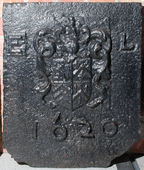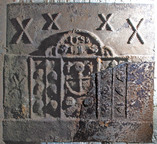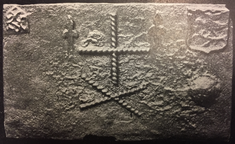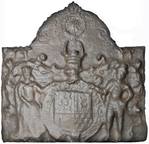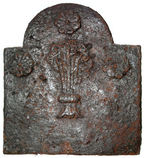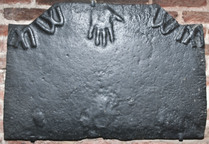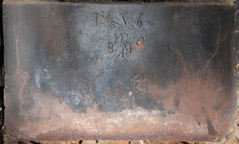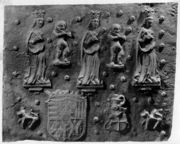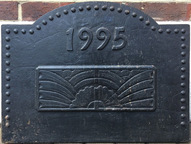-
232
Description: Plain plate; central shield, helm, crest and mantling of the Lewis family: quarterly 1st, sable a lion rampant argent (Lewis of Y Fan), 2nd, sable a chevron between three fleurs de lys or (Einon ap Collwyn), 3rd gules three chevronels argent(Iestyn ap Gwrgan), 4th, sable a chevron between three spear heads argent embrued gules (Bleddyn ap Maenyrch); initials split by armorial stamp (’E’ over-stamped); date, formed from single numerals, below arms.
Notes: The arms are those of Sir Edward Lewis, of Van, who purchased St Fagans Castle in 1616. The same armorial stamp was used to model the arms on a lead cistern outside the front door of the castle. It is possible that this fireback was cut down from a larger fireback.
Inscription: E L 1620
Arms: Sir Edward Lewis of Van
- Decoration tags:
- sub-rectangular (shape)
- none (edging)
- carved stamps
- individual letters
- individual numbers
- armorial
- text
Manufactured: in 1620 in the South Wales area of Wales.
Current location: National History Museum, St Fagans, Glamorgan, Wales.
Museum number: 48.354/84 (part of the Welsh National History Museum museum group)
- Attached to series:
- Personal armorial firebacks
- Welsh armorial firebacks
- Bristol armorial series
-
815
 ? x ? mmImage subject to copyright
? x ? mmImage subject to copyrightDescription: Arched rectangular shape with crown, top centre; central peacock, its tail feathers displayed, with two other peacocks below, their tail feathers down; name across top of arch, split by initial, R; date ato bottom below tail feathers.
Notes: Manufactured by Seager's of Dartford, Kent
Inscription: CHARLES FRANCIS / R / 1967
- Decoration tags:
- arched rectangular (shape)
- none (edging)
- whole carved pattern
- pictorial
- text
- animals
Manufactured: in 1967 in England.
Current location:, not known.
- Attached to series:
- Personal firebacks
-
1148
Description: A composite recasting placing, on a plain background with symmetrical rope saltires, a recast variant of the ‘Armada’ fireback, with changed initials, a single anchor panel, and the addition of plain base and borders, the latter each with a twisted rope saltire, upper middle.
Notes: It is likely that an original four-panel fireback was used to cast an early copy with additional side and base panels. In the 19th century this second fireback was used to cast this third fireback with an additional full-width extension on top bearing four symmetrical rope saltires, the outer two larger than the inner two. The image of this fireback has been reconstructed by computer, combining photographs of the two fragments into which it had been broken.
Inscription: 1588 / IK
- Decoration tags:
- rectangular (shape)
- none (edging)
- simple stamps
- carved pattern panels
- composite
- apotropaic
- text
- plants
- objects
Manufactured: in the early to mid 19th century in England.
Current location: Chawton House, Chawton, Hampshire, England.
- Attached to series:
- Armada series
- Composite firebacks
-
1195
Description: Rectangular shape; no edging; top centre, cross formed of two lengths of twisted rope, with a flattened saltire of the same below; top right, a shield, indented at the top, charged with a bird upon a branch, below which is an indeterminate semi-spherical feature; on each side of the cross, a stylised fleur-de-lys in low relief; top left, an inverted shield with indeterminate decoration (suggested by Christy to be IC).
Notes: The cross and saltire will have had an apotropaic purpose. Illustration from Christy 1908, who stated it was in Buxted, East Sussex.
- Decoration tags:
- rectangular (shape)
- none (edging)
- simple stamps
- carved stamps
- heraldic
- apotropaic
- objects
Manufactured: in the early to mid 16th century in the Weald area of England.
Current location:, not known.
- Attached to series:
- Bird shield series
- Rope design firebacks
-
1259
Description: Plain rectangular plate; shield, garter, helm, mantling and supporters of the Blount family, Lords Mountjoy; above, a Garter enclosing a sun charged with an eye, all surmounted by an earl's coronet; decorative edging of the arch in low relief.
Notes: The arms are those of Charles Blount, 8th Baron Mountjoy (1563-1606), who was invested Knight of the Garter in 1597. He was created 1st Earl of Devonshire in 1603 and the original fireback, of which this is probably a copy, therefore dates from between 1603 and 1606. Blazon: 1. (Blount) Barry nebuly of six Or and Sable; 2. (Ayala) Argent, two wolves passant Sable on a bordure of the first eight saltires Gules; 3. (Mountjoy) Or a tower Azure; 4. (Gresley) Vair. The fireback was made by taking a worn casting of the Mountjoy arms (for a clearer example see no. 740) and using it as a pattern, adding an extension above with the decorative edging and the crowned Garter and sun, the detail of which is sharper than the armorial below. The Garter and sun as a badge of Charles Blount has been noted on two contemporary book bindings. The fireback may have come from Dedisham Manor in West Sussex, which belonged to a cadet branch of the Blount family from 1545 to 1636 and which, in the latter year, was sold to Richard Onslow who later built Clandon Park.
Inscription: Garter motto [mostly illegible]
Arms: Charles Blount, KG, 8th Baron Mountjoy, Earl of Devonshire
- Decoration tags:
- arched rectangular (shape)
- none (edging)
- carved stamps
- whole carved pattern
- heraldic
- armorial
Manufactured: in the early 17th century possibly at Dedisham Furnace, Rudgwick in the Weald area of England.
Current location: Clandon Park, West Clandon, Surrey, England.
Museum number: 1441937 (part of the National Trust museum group)
- Attached to series:
- Personal armorial firebacks
- Mountjoy series
-
896
Description: Arched rectangular shape; no edging; three 'daisy' flowerheads, top centre and in each shoulder; central plume of six ostrich feathers issuing from what appears to be a wreath surmounting a tree stump.
Notes: Excavated from the ruins of Cloughoughter Castle in County Cavan, which had been rendered uninhabitable in a siege of 1653. Until the early 16th century the castle had been in the hands of the O'Reilly family. On some versions of the O'Reilly arms the crest is shown as a plume of ostrich feathers, although this may be a misrepresentation of the usual crest of a tree with a snake entwined about it.
- Decoration tags:
- arched rectangular (shape)
- none (edging)
- carved stamps
- heraldic
- plants
Manufactured: in the early 17th century in Ireland.
Current location: Parke's Castle, Fivemile Bourne, Co. Leitrim, Ireland.
(part of the Heritage Ireland museum group)
- Attached to series:
- Miscellaneous stamp firebacks
-
1113
Description: Quasi-rectangular with a three-facetted arch; top centre, left hand print; around each shoulder, M W mirrored.
Notes: The likelihood is that the M and W are formed of a double-V (virgo virginum) intended to symbolise the Virgin Mary and have an apotropaic (evil-averting) purpose. It may be of significance that hand prints seen on firebacks are always of the left hand.
Inscription: MW WM
- Decoration tags:
- triple-facetted arched rectangular (shape)
- none (edging)
- simple stamps
- individual letters
- apotropaic
- text
- humans
Manufactured: in the early 17th century possibly in the Weald area of England.
Current location: in private hands, Crowborough, East Sussex, England.
- Attached to series:
- Hand print firebacks
-
911
Description: Plain rectangular plate; no edging; top centre, date with '7' reversed; below date, initials in triad.
Notes: The reversed '7' indicates that the numerals, and probably the letters, had no backing; the initials are probably those of a husband and wife whose surname began with 'H'.
Inscription: 1676 / BHM
- Decoration tags:
- rectangular (shape)
- none (edging)
- carved stamps
- individual letters
- individual numbers
- text
Manufactured: in 1676 in the Weald area of England.
Current location: in private hands, Crowhurst, East Sussex, England.
- Attached to series:
- Date & initials firebacks
-
1025
Description: Quasi-rectangular shape; top, crowned robed statuary figure holding a book, repeated three times, interspersed with a naked child statuary figure playing a flute; bottom, shield and coronet to left, small shield, helm and crest to right, all between a crude dog figure repeated on each side; the whole plate dotted randomly with a repeated small gadrooned bead stamp.
Notes: The figures are from wall-mounted statuary. The shield and coronet are those of the Duchy of Lorraine prior to 1538; blazon: Quarterly, 1. barry of eight gules and argent (Hungary) impaling azure semy-de-lis Or a label gules (Naples); 2. argent a cross potent and four crosslets Or (Jerusalem) impaling Or four pallets gules (Aragon); 3. azure semy-de-lis Or a bordure gules (Valois-Anjou); 4. azure crusilly fitchy, two barbels addorsed Or (Bar); overall an inescutcheon Or a bend gules three alerions argent (Lorraine). The figure holding the book is that of St Catherine of Siena (see von den Driesch, pp. 220, 222).
Arms: Duchy of Lorraine
- Decoration tags:
- quasi-rectangular (shape)
- none (edging)
- carved stamps
- heraldic
- historical
- armorial
- animals
- humans
- objects
Manufactured: in the early 16th century in the Lorraine area of Germany.
Current location: not known.
- Attached to series:
- Foreign armorial firebacks
-
1266
Description: Arched rectangular shape; plain edge with 49 large beads parallel with top and sides; upper centre, date in bold Arabic numerals; below date, raised rectangular panel with chamfered sides and corners and fillet edging, and a symmetrical sunburst and rainbow design in low relief.
Notes: Modern, quasi-Art Deco design
Inscription: 1995
- Decoration tags:
- arched rectangular (shape)
- none (edging)
- whole carved pattern
- individual numbers
- text
- objects
Manufactured: in 1995 in England.
Current location: in private hands Croydon, Greater London, England.
- Attached to series:
- Miscellaneous pattern firebacks
- 1990s Art Deco series
